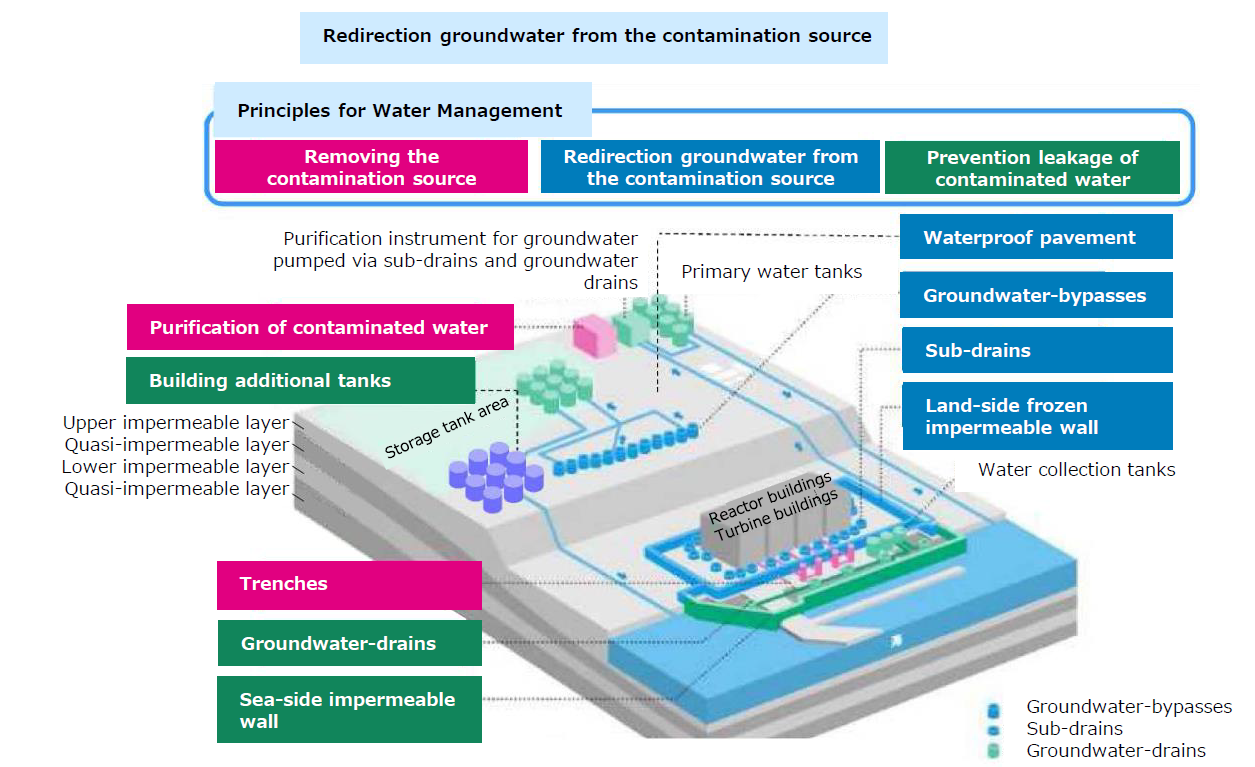Fight against contaminated water: The generation of contaminated water steadily reduced to about one-third
(in provisional translation)
(English ver.) 2020-04-22

(Source) Tokyo Electric Power Company Holdings, Inc.
Due to the accident at TEPCO’s Fukushima Daiichi Nuclear Power Station (Fukushima Daiichi NPS) caused by the Great East Japan Earthquake, contaminated water with radioactive substances has been generated. This article updates the fight against contaminated water by elaborating on the effectiveness of various countermeasures with emphasis on the following points:
-
 Contaminated water will continue to be generated as long as fuel debris needs to be cooled by water.
Contaminated water will continue to be generated as long as fuel debris needs to be cooled by water.
-
 Current generation of contaminated water is approximately one-third of the amount before countermeasures were taken.
Current generation of contaminated water is approximately one-third of the amount before countermeasures were taken.
-
 Current measures will be continued with the aim of reducing generation to about 150 tons per day by the end of 2020.
Current measures will be continued with the aim of reducing generation to about 150 tons per day by the end of 2020.
Why is “contaminated water” being generated?
Due to the accident at Fukushima Daiichi NPS caused by the Great East Japan Earthquake, hydrogen explosions occurred within reactor buildings and nuclear fuel melted down. Fuel that melted down and solidified inside the reactor still remains and is known as “fuel debris”.
Fuel debris needs continuous cooling with water. When water comes into contact with the fuel, it makes a certain amount of “contaminated water” with high concentrations of radioactive substances.
It is of primary importance to prevent contaminated water from flowing out of the building. For this purpose, the level of water inside the building is maintained at a lower level than that of the groundwater surrounding the building. The difference in water levels inside and outside the building prevents the contaminated water from leaking out of the building. However, groundwater surrounding the building tends to flow toward lower levels, namely inside the building. This, coupled with rainwater flowing into the building through damaged roofs, makes additional contaminated water. Therefore, as long as fuel debris needs to be cooled by water, it is impossible to stop generating contaminated water immediately.
Various countermeasures to reduce the amount of contaminated water generation
Various countermeasures are being taken with direct involvement by the government on the basis of the following three principles:
-
 1. No leakage
1. No leakage
-
 2. No inflow of water
2. No inflow of water
-
 3. Removal of contaminants
3. Removal of contaminants
In terms of Number 1 above, it is of vital importance not to leak contaminated water to the outside. As for Number 2 above, groundwater is to be kept away from the building so as to minimize additional contaminated water generation. As for Number 3 above, in order to reduce risks associated with contaminated water, radioactive substances are to be removed.
With regard to “2. No inflow of water”, the goal of reducing the generation of contaminated water to 150 and 100* tons per day by the end of 2020 and 2025, respectively, has been established. In order to achieve this objective, multi-layered measures are being taken to reduce contaminated water generation by suppressing the amount of water flowing into the buildings.
*This goal is newly established in 5th revision of “the Mid-and-Long term Roadmap” (December 27, 2019)
- Main measures to reduce contaminated water generation
- [Groundwater bypasses]
Wells (groundwater bypasses) have been dug on the high ground on the mountain side of the facility so that groundwater can be pumped up before it approaches the buildings. Pumped-up groundwater is analyzed both by TEPCO and an independent organization. The water is discharged after the analyses confirm the concentration of radioactive substances falls within the standards (operational target set by TEPCO).
[Sub-drains]
Wells (sub-drains) have been dug near the buildings so that groundwater can be pumped out to lower the level of groundwater surrounding the buildings, which reduces the amount of groundwater flowing into the buildings. Pumped-up groundwater is processed for purification and discharged after confirming that the concentration falls within the operational targets as in the case with groundwater bypass wells.
[Facing]
The site is paved with materials such as mortar which prevents rainwater from penetrating the ground to make more groundwater.
[Land-side impermeable walls (frozen soil walls)]
Frozen soil walls have been installed surrounding the buildings to control the inflow of groundwater. Refrigerant is supplied into the “freezing pipes” that freeze the surrounding soil to make frozen soil walls.
[Damaged roofs to be repaired]
Repair work on the damaged roofs of the buildings is being carried out in order to prevent rainwater from flowing into the building.
Status in the spring of 2019
Regarding “2. No inflow of water” 540 tons of contaminated water was being generated per day in May, 2014 when countermeasures were yet to be taken. It was reported that the generation of contaminated water had reduced to about 220 tons per day in FY2017 thanks to the various countermeasures. With continuous efforts being made, the amount further reduced to about 170 tons per day in 2018.
Amount of contaminated water generated (tons per day)
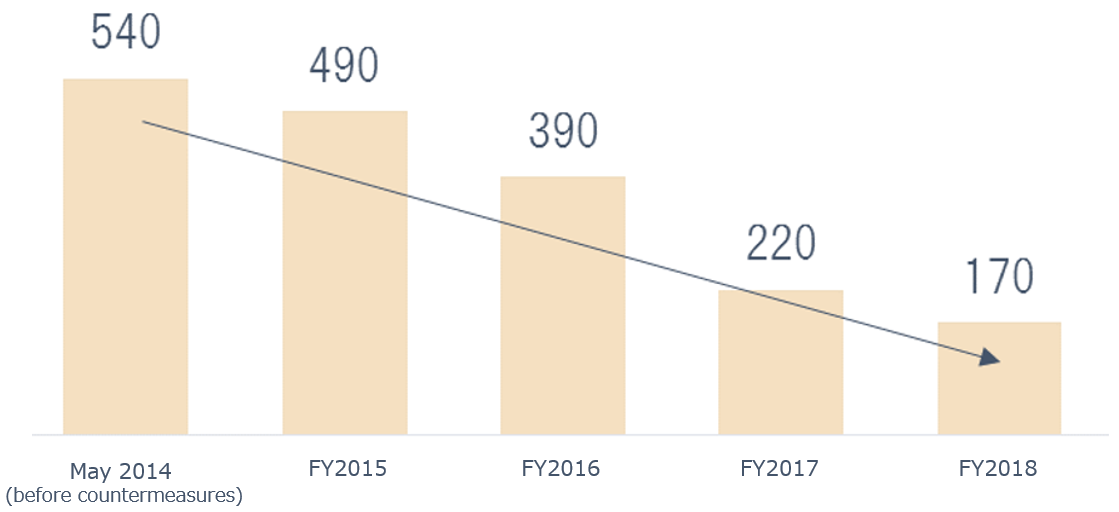
Groundwater pumped up by wells (sub-drains) surrounding the buildings is processed for purification and discharged after analysis confirms that the concentration falls within the “operational targets”, which are stricter criteria than the regulatory standards.
Since September, 2015 when the facilities started operation, discharging pumped-up groundwater continued once a day or once every few days, with the 1000th discharge carried out on June 20, 2019. As stated above, it is an important key to fight against contaminated water by using such effective facilities installed for decommissioning.
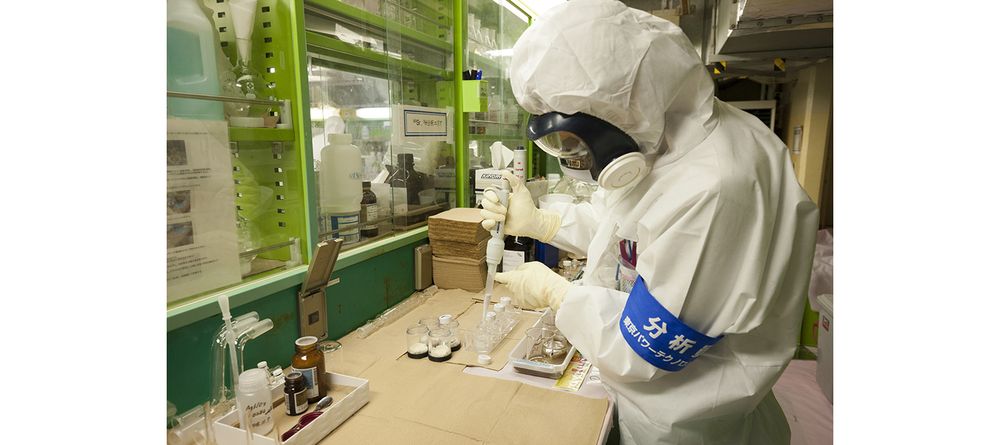
(Source) Tokyo Electric Power Company Holdings, Inc. Groundwater pumped up by groundwater bypass wells and sub-drains is analyzed by both TEPCO and an independent organization.
[Reference] Comparison between “operational objectives” and regulatory standards
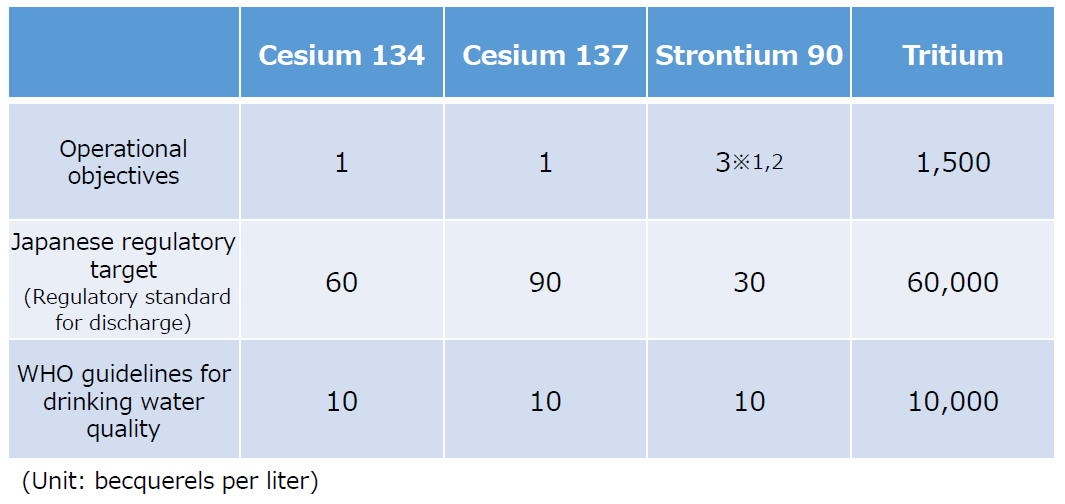
*1 Confirming once every ten days or so that the concentration is less than 1 becquerel.
*2 Analyzing concentrations of all nuclides that emit beta rays including strontium 90
Thanks to the countermeasures such as the sea-side impermeable wall, coastal waters near Fukushima Daiichi NPS have shown a significant improvement in quality with the radiation levels well below the Guidance value recommended in the WHO (the World Health Organization) “Guidelines for drinking water quality”.
Monitoring of seawater near the south discharge channel
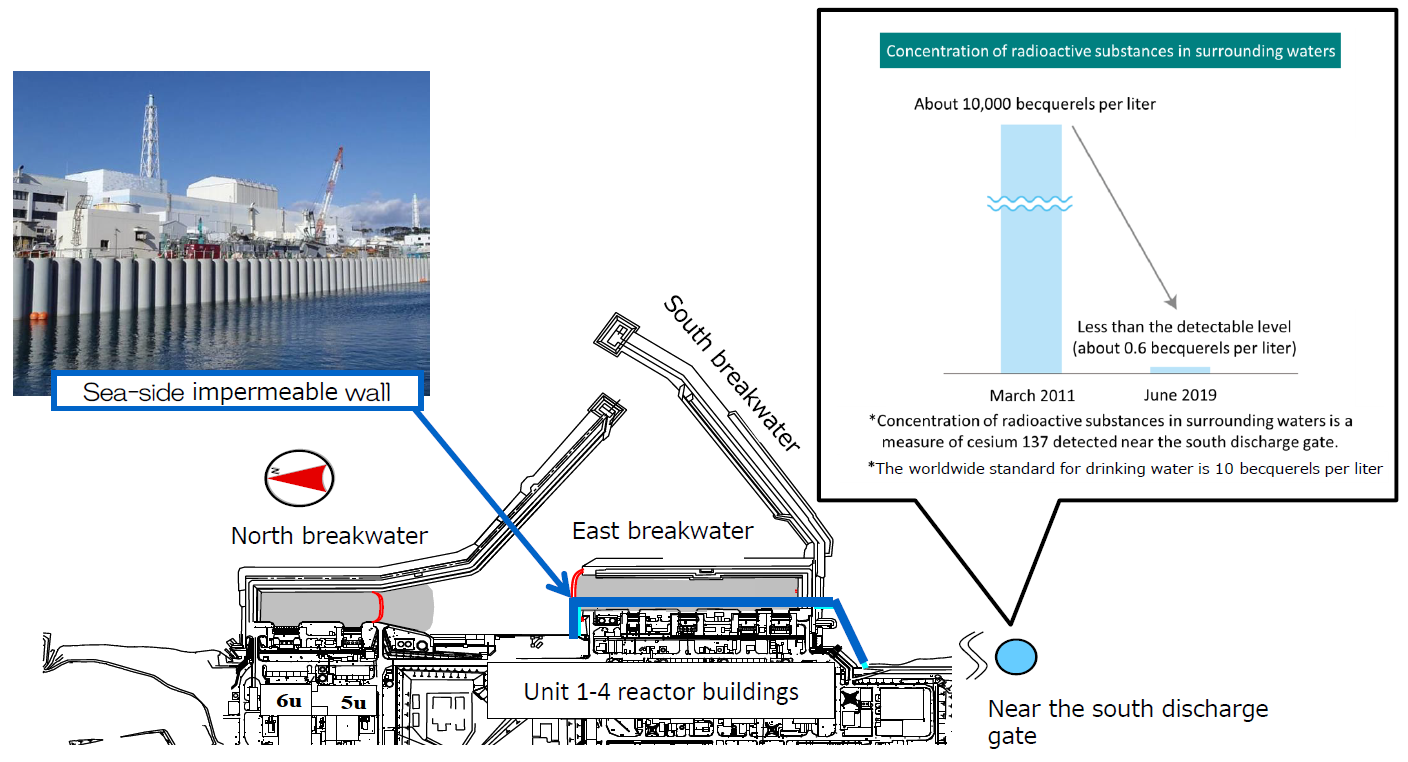
Actions to be taken in the future
In order to prevent rainwater from flowing into the buildings, damaged roofs are to be repaired to minimize additional generation of contaminated water with the aim of reducing its generation to about 150 and 100 tons per day by the end of 2020 and 2025, respectively. Contaminated water left in the buildings is being processed according to plan. All the contaminated water left in the buildings, other than reactor buildings where fuel debris is being cooled, will be treated by the end of 2020*.
*Excluding the reactor buildings of Unit 1-3, process main buildings, and High temperature incineration building.
Contaminated water is purified through the facilities such as the multi-nuclide removal equipment (ALPS) to reduce risks, and stored in the on-site tanks under proper management.
As explained above, the contaminated water situation has been stabilized compared to immediately after the accident. However, the fight against contaminated water will not end until decommissioning is completed. Countermeasures based upon the three principles must continue to be taken. In addition, measures against natural disasters are also to be put in place including the construction of a tide embankment. All these efforts will contribute to steady progress of the long-term decommissioning process.
Division in charge
About the article
Nuclear Accident Response Office, Electricity and Gas Industry Department
About Special Contents
Research and Public Relations Office, Policy Planning and Coordination Division, Commissionerʼs Secretariat
![]() The original Japanese text of this article; Click here
The original Japanese text of this article; Click here
